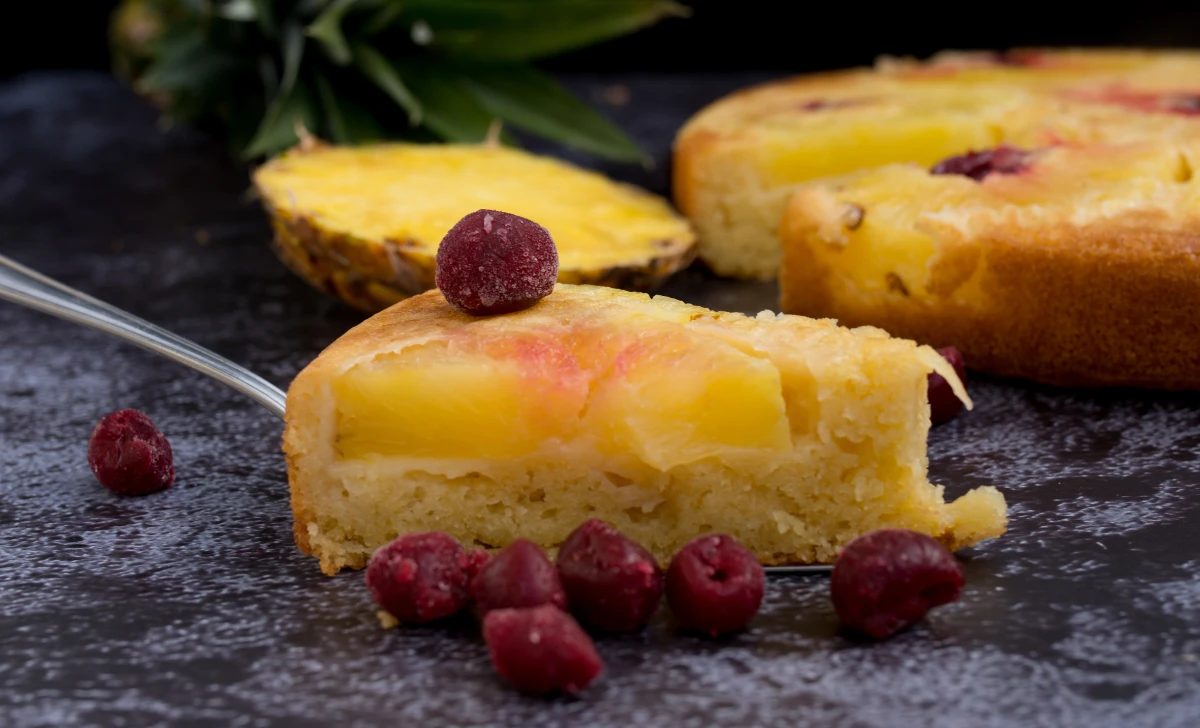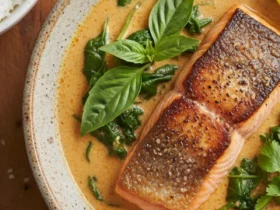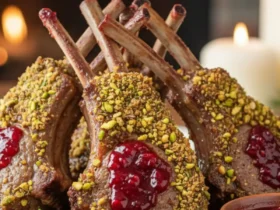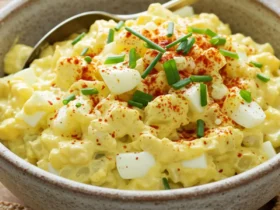Are you ready to embark on a delightful baking adventure? Look no further than this Pineapple Upside-Down Cake recipe. Whether you’re an experienced baker or just starting out, this classic dessert is sure to bring a smile to your face and a burst of flavor to your taste buds. In this article, we’ll guide you through each step, from choosing the juiciest pineapple to savoring your homemade masterpiece. So, grab your apron and let’s get baking!
[ez-toc]
History
Delving into the history of the Pineapple Upside-Down Cake is like uncovering a treasure trove of culinary evolution and cultural fusion. This beloved dessert has a rich backstory that spans centuries and continents, blending the flavors of different eras and regions into a delectable masterpiece.
Early Inspirations and Colonial Beginnings
The roots of the Pineapple Upside-Down Cake trace back to a time when exotic fruits were scarce and coveted by those with a taste for the extraordinary. Pineapples, in particular, were symbols of wealth and hospitality, often reserved for special occasions. In the 17th century, as European exploration expanded trade routes, these spiky gems found their way from the tropics to the tables of the privileged.
As colonization spread across the Americas, European settlers brought their culinary traditions with them. The concept of “flipping” cakes, where ingredients were placed at the bottom of a skillet and then inverted after baking, was not new. This method allowed bakers to create caramelized toppings, harnessing the heat to transform sugar into a luscious sauce.
A Marriage of Ingredients and Creativity
By the 19th century, with advancements in baking techniques and the availability of ingredients, the Pineapple Upside-Down Cake began to take on a more familiar form. Cast iron skillets became commonplace in kitchens, providing the perfect vessel for creating the iconic caramelized pineapple topping. Home cooks started experimenting with different fruits and flavors, adapting the basic concept to suit their tastes.
The combination of pineapple and maraschino cherries, nestled into the buttery caramel, became a hallmark of the cake. The bright colors and tropical flavors created an enchanting contrast with the golden cake base, making it a visual and gustatory delight.
Rising Popularity and Cultural Symbolism
As the 20th century dawned, the Pineapple Upside-Down Cake gained popularity across the United States. It became synonymous with hospitality, warmth, and comfort, embodying the spirit of Southern cooking. The cake became a staple at potlucks, family gatherings, and celebrations, symbolizing the joy of sharing and the pleasures of simple indulgence.
Advertisements in magazines and cookbooks of the era further popularized the cake, showcasing its elegant appearance and emphasizing its ease of preparation. The advent of canned pineapple made the recipe more accessible to a wider audience, further solidifying its place in American culinary culture.
Modern Variations and Global Influence
As the world became more connected, the Pineapple Upside-Down Cake journeyed beyond American shores. Its timeless appeal and adaptable nature led to creative interpretations in various cuisines. Different fruits, regional spices, and local ingredients were incorporated, giving rise to a global array of upside-down cakes.
In Hawaii, where pineapples thrived, the cake became a symbol of the islands’ agricultural heritage. In Brazil, the “Bolo de Abacaxi” features pineapple and coconut, echoing the nation’s tropical identity. Throughout Europe, variations emerged, each one embracing the core concept while infusing local flavors.
Continuing the Tradition
Today, the Pineapple Upside-Down Cake stands as a testament to the enduring nature of comfort food and the power of culinary innovation. It remains a cherished dessert that bridges the gap between tradition and modernity, delighting generations with its sweet nostalgia and irresistible flavors.
So, as you embark on your own Pineapple Upside-Down Cake baking adventure, remember that you’re not just creating a dessert; you’re participating in a culinary legacy that spans continents and cultures. With every bite, you’re savoring a slice of history and the sweet evolution of a time-honored treat.
Time
| Step | Time |
|---|---|
| Selecting the Perfect Pineapple | 10 minutes |
| Preparing the Cast Iron Skillet | 5 minutes |
| Creating the Caramelized Bliss | 15 minutes |
| Mixing the Batter with Love | 10 minutes |
| Layering with Care | 5 minutes |
| The Baking Ritual | 30-35 minutes |
| Unveiling the Upside-Down Beauty | 5 minutes |
| Savoring Every Bite | Timeless |
| Storage and Serving Suggestions | 5 minutes |
| Sharing the Love | Timeless |
| Common Mistakes to Avoid | 5 minutes |
| Customizing Your Creation | 10 minutes |
Ingredients
| Ingredients | Quantity |
|---|---|
| Butter | 1/4 cup |
| Brown sugar | 1/4 cup |
| Pineapple slices (fresh or canned) | 4 slices |
| Maraschino cherries | 4 cherries |
| All-purpose flour | 1/2 cup |
| Baking powder | 1/2 teaspoon |
| Salt | 1/4 teaspoon |
| Granulated sugar | 1/4 cup |
| Eggs | 1 |
| Vanilla extract | 1/2 teaspoon |
| Milk | 1/4 cup |
Directions
Step 1: Selecting the Perfect Pineapple
- Look for a pineapple with vibrant green leaves, a firm body, and a sweet aroma at the base.
- The color should be golden, indicating ripeness.
- If a leaf from the crown easily plucks off, your pineapple is ripe and ready.
Step 2: Preparing the Cast Iron Skillet
- Melt 1/4 cup of butter and coat the bottom of the cast iron skillet.
- Sprinkle 1/4 cup of brown sugar evenly over the buttered surface.
Step 3: Creating the Caramelized Bliss
- Arrange 4 pineapple slices on the caramel bed, ensuring an even distribution.
- Place 4 maraschino cherries in the center of each pineapple ring.
- The heat will transform the butter-sugar mixture into a rich caramel sauce.
Step 4: Mixing the Batter with Love
- In a mixing bowl, whisk together 1/2 cup of all-purpose flour, 1/2 teaspoon of baking powder, and a pinch of 1/4 teaspoon salt.
- In another bowl, beat 1/4 cup of granulated sugar and the melted butter until light and fluffy.
- Add 1 egg, 1/2 teaspoon of vanilla extract, and 1/4 cup of milk. Mix until smooth.
- Gradually incorporate the dry ingredients, whisking until the batter is velvety smooth.
Step 5: Layering with Care
- Gently pour the batter over the pineapple and cherries, ensuring even coverage.
- The batter will encase the fruit, creating a delightful surprise when the cake is flipped.
Step 6: The Baking Ritual
- Preheat the oven to 350°F (175°C).
- Carefully transfer the skillet to the preheated oven.
- Bake for 30-35 minutes, or until a toothpick inserted into the center emerges clean.
- The heavenly scent of caramel and pineapple will fill your kitchen.
Step 7: Unveiling the Upside-Down Beauty
- Remove the skillet from the oven and place a serving plate over the top.
- With a deep breath and steady hands, swiftly flip the skillet to release the cake onto the plate.
- Lift the skillet gently, revealing the masterpiece you’ve created.
Step 8: Savoring Every Bite
- Allow the cake to cool slightly before slicing.
- Cut a generous slice and marvel at the layers of caramelized pineapple and moist cake.
- Take a bite and let the flavors transport you to dessert paradise.
Step 9: Storage and Serving Suggestions
- Store any leftover cake in an airtight container to keep it fresh.
- Enjoy the cake warm or at room temperature, and consider adding whipped cream or ice cream for extra indulgence.
Step 10: Sharing the Love
- Share your delicious creation with family and friends.
- Witness the joy your baking brings as they savor each delectable bite.
Step 11: Common Mistakes to Avoid
- Be cautious of overmixing the batter, using too much fruit, or not caramelizing the pineapple sufficiently.
- Follow the steps carefully to ensure a successful outcome.
Step 12: Customizing Your Creation
- Feel free to experiment with different fruits, spices, or additions to make the recipe uniquely yours.
- Let your culinary creativity shine!
Now that you’ve followed these steps, you’re ready to enjoy the fruits of your labor—a slice of Pineapple Upside-Down Cake that’s sure to impress and delight!
Equipment Required
Nutrition Information
| Nutrition Information | Per Serving (1 slice) |
|---|---|
| Serving Size | 1/8 of cake |
| Calories | 250 |
| Total Fat | 10g |
| – Saturated Fat | 6g |
| Cholesterol | 50mg |
| Sodium | 150mg |
| Total Carbohydrates | 38g |
| – Dietary Fiber | 1g |
| – Sugars | 24g |
| Protein | 3g |
| Vitamin D | 2% DV |
| Calcium | 6% DV |
| Iron | 6% DV |
| Potassium | 2% DV |
Percent Daily Values (% DV) are based on a 2,000-calorie diet.
Please note that these values are approximate and can vary based on factors such as the specific ingredients and portion sizes used in the recipe.
Tips
- Pineapple Prep: If using fresh pineapple, remove the tough core before slicing. Pat the slices dry with a paper towel to prevent excess moisture in the cake.
- Caramelization: When creating the caramel layer, make sure to evenly distribute the butter and brown sugar to ensure consistent sweetness.
- Skillet Size: Use an appropriately sized skillet to accommodate the pineapple slices and batter. A 9-inch skillet is generally a good choice.
- Even Layering: Arrange the pineapple slices in a single layer and place cherries in the center of each slice. This will ensure even distribution and a visually appealing pattern.
- Flour Dusting: Lightly flour the pineapple slices before pouring the batter to prevent them from sinking to the bottom.
- Cooling Time: Allow the cake to cool slightly before flipping it onto the plate. This reduces the risk of the cake breaking or sticking to the skillet.
Pros & Cons
| Pros | Cons |
|---|---|
| ✅ Delightful tropical flavors | ❌ Moderate in calories and sugar |
| ✅ Impressive visual appeal | ❌ Contains saturated fat |
| ✅ Versatile – customizable fruits | ❌ May not be suitable for certain dietary restrictions (vegan, gluten-free) |
| ✅ Nostalgic comfort food | ❌ Requires attention to caramelization for optimal results |
| ✅ Perfect for sharing and celebrations | ❌ Involves multiple steps and baking time |
Conclusion
In the world of baking, where flavors and memories intertwine, the Pineapple Upside-Down Cake stands as a testament to the joy of indulgence. From the moment you select the perfect pineapple to the triumphant unveiling of the caramelized masterpiece, this recipe encapsulates the art of baking with its sweet nostalgia and tropical allure.
With every slice, you’ll experience the harmonious dance of caramelized pineapple and tender cake—a symphony of flavors that transports you to a paradise of taste. The recipe’s simplicity and versatility make it a canvas for your culinary creativity, allowing you to infuse it with your unique touch and flavor preferences.
While the process involves steps and patience, the end result is a slice of comfort and celebration, perfect for sharing with loved ones or enjoying on your own. Whether you’re a baking novice or a seasoned enthusiast, this recipe invites you to create a treat that embodies both tradition and innovation.
So, why not embark on this delightful journey? Embrace the aroma that fills your kitchen, the anticipation as the cake bakes, and the satisfaction as you savor each bite. The Pineapple Upside-Down Cake isn’t just a dessert; it’s a heartwarming experience that brings people together and leaves you craving another slice. Join the ranks of bakers who’ve experienced the magic, and let your taste buds revel in the sweetness of tradition and the joy of exploration. Happy baking! 🍍🍰
Facts
- Fact 1: Pineapple Prestige 🍍
- Did you know that in the 18th century, a single pineapple on your table was a status symbol? Pineapple Upside-Down Cake was born from a desire to showcase this exotic fruit’s luxury in the most delightful way.
- Fact 2: Sweet Serendipity 🍒
- The maraschino cherry’s debut wasn’t in a cake but in cocktails! It found its way into the Pineapple Upside-Down Cake recipe as a colorful and tasty addition, creating a flavor symphony with the caramelized pineapple.
- Fact 3: The Gravity-Defying Flip 🙃
- Flipping a cake upside down can be a daring feat. But fear not! The idea of flipping cake recipes dates back centuries to the Middle Ages when cakes were cooked on griddles. The Pineapple Upside-Down Cake flip is all about unveiling the caramelized magic.
- Fact 4: A Slice of Hawaiian Paradise 🌺
- Hawaii became synonymous with pineapples, and the Pineapple Upside-Down Cake is a culinary ode to this tropical paradise. It’s like a mini vacation for your taste buds, transporting you to sandy beaches and swaying palm trees with every bite.
- Fact 5: The 1950s Nostalgia 🕺
- In the 1950s, the Pineapple Upside-Down Cake reached new heights of popularity, thanks to the post-war economic boom. It became a beloved symbol of homey nostalgia and good old-fashioned American comfort, enjoyed at picnics, potlucks, and family gatherings.
FAQ’s
Can I use canned pineapple for this recipe?
Absolutely! Canned pineapple works well. Just make sure to drain it thoroughly before using, so excess moisture doesn’t affect the cake’s texture.
What alternative fruits can I use besides pineapple?
While pineapple is classic, you can get creative! Try peaches, pears, or even apple slices for a unique twist on the traditional recipe.
Why did my cake turn out soggy?
Sogginess can result from excess moisture. Ensure pineapple slices are patted dry before layering, and don’t overcrowd the skillet with fruit.
Can I use a different type of cake batter?
Certainly! Feel free to experiment with your favorite cake batter recipe. Just make sure it’s thick enough to hold the fruit and caramel layer.
How do I prevent the cake from sticking to the skillet?
Properly grease the skillet before layering ingredients to prevent sticking. Allow the cake to cool slightly before flipping to release it easily.
Can I make this recipe vegan?
Yes, you can! Use vegan butter, egg substitutes, and plant-based milk. The result will still be delicious, with a slight twist in flavor.
How long does the cake stay fresh?
Store any leftover cake in an airtight container at room temperature for up to 2 days. Consider refrigerating for longer shelf life.
Can I use a different type of sweetener instead of brown sugar?
While brown sugar adds depth, you can experiment with alternatives like coconut sugar or maple syrup. Adjust quantities to taste.
Can I make this gluten-free?
Yes! Use a gluten-free all-purpose flour blend. Ensure it’s suitable for baking and follow the recipe as usual.
Can I freeze Pineapple Upside-Down Cake?
Yes, you can freeze individual slices. Wrap them tightly in plastic wrap and store in an airtight container for up to 2 months. Thaw in the refrigerator before enjoying.












Leave a Review